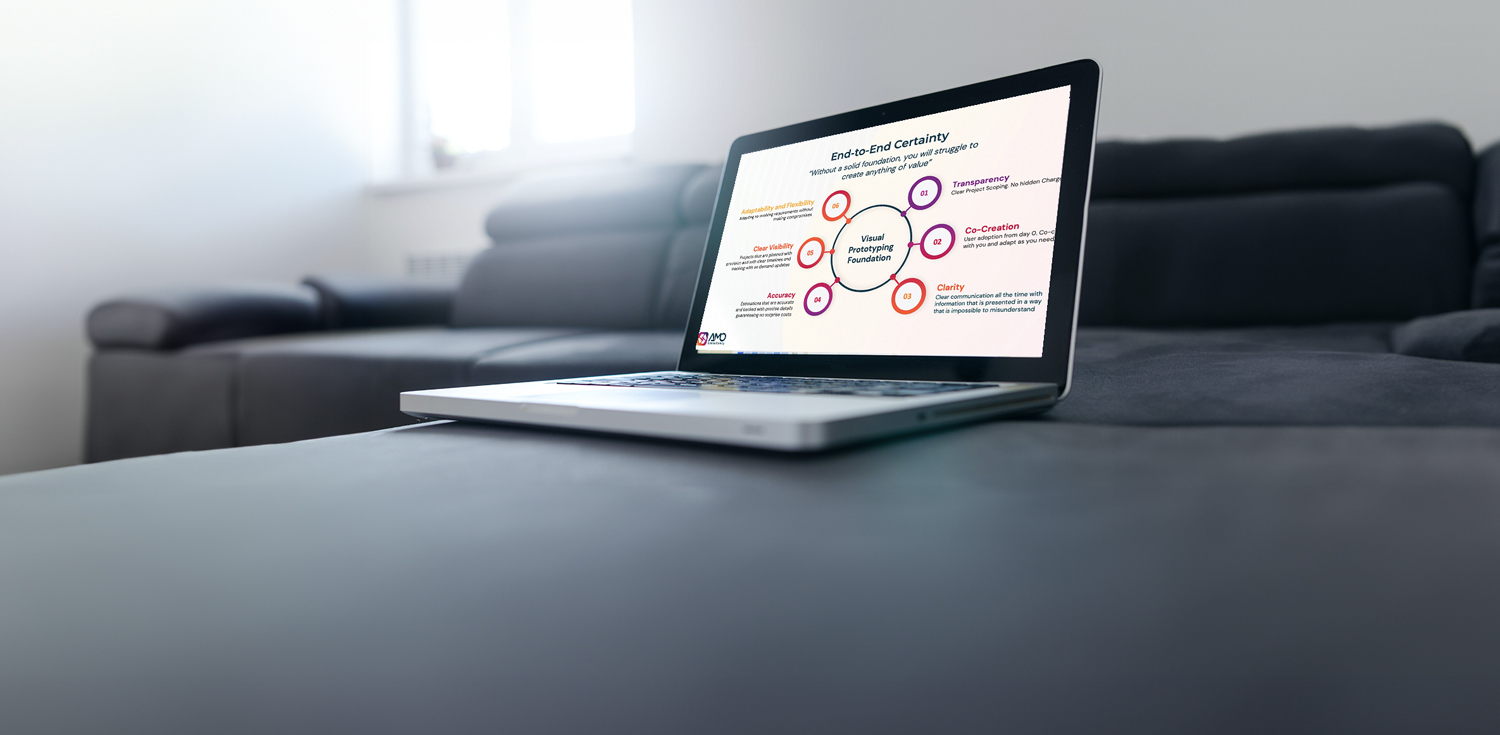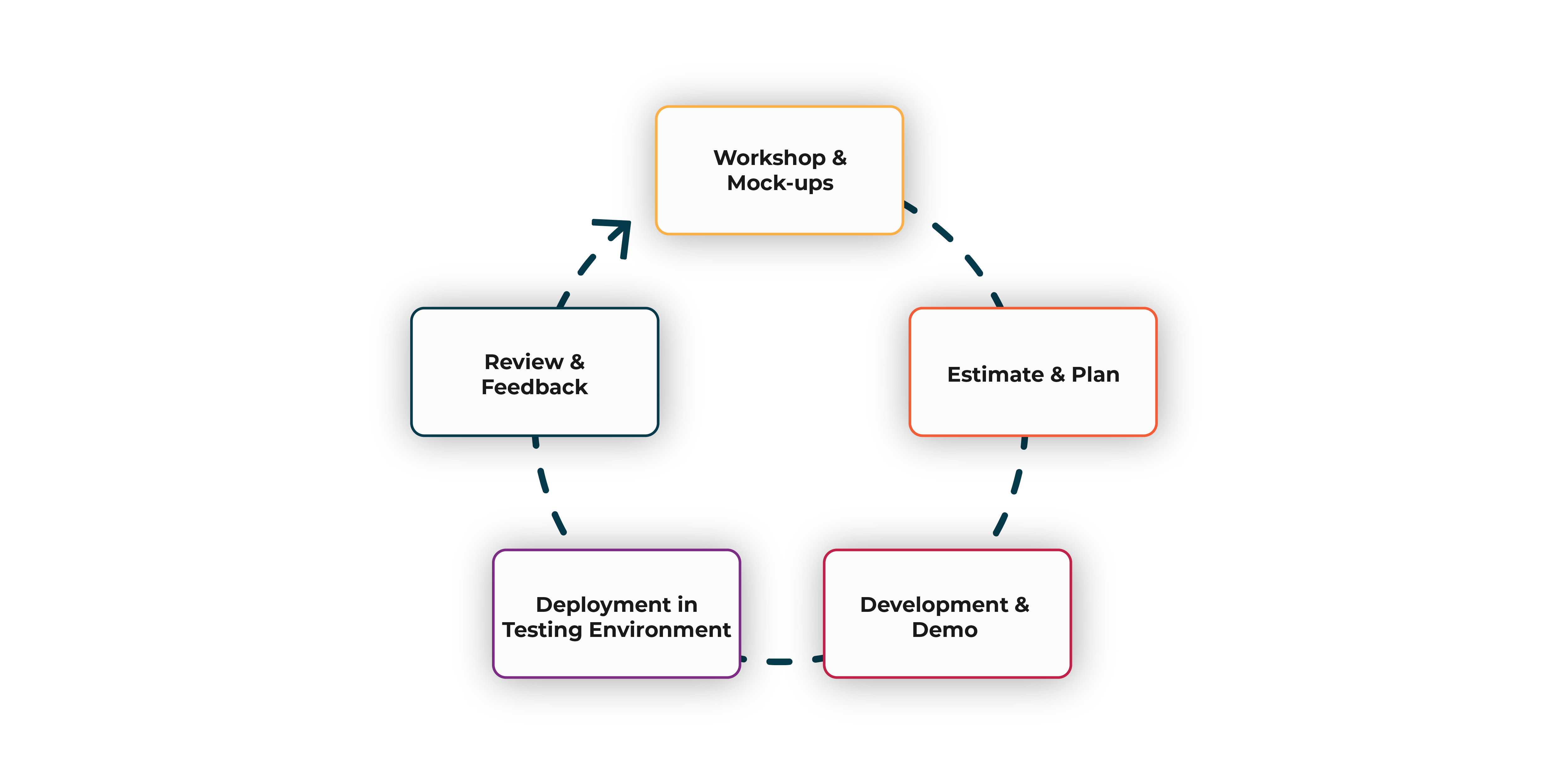
At AMO, we are committed to delivering tailor-made and optimised business process solutions. Sounds pretty generic, right? So how are we different from the thousands of companies advertising with similar buzzwords and phrases like ‘digital transformation’?
Well, that is what this article is about. What we do is build tailor-made applications to do exactly what you want, exactly how you imagined it. Thanks to our unique delivery methodology we create apps that align precisely with your vision. Call it disruptive if you must, but I see it as streamlining, we focus on simplicity and directness, breaking away from the basic run-of-the-mill app delivery approach.
Our core values guide our approach to business and method of work. Let’s go through these before delving into more details:
Preparation is key to success and this is a must for any project, so how do we approach it? Mock-ups. Or what we like to call visual prototypes.
We use a visual representation to merge your needs with our expertise and best practices, creating not just a sketch but something as close as possible to the final product. User stories? More like snoozer stories. It takes too long to write and no one ever reads them anyway. We ramp up efficiency at the workshop stage by several degrees of magnitude compared to classic approaches. That means shorter meetings and clear outputs faster. With visual prototypes, we can include client requests practically in real time and give insight into how they will look. But looks aren’t everything, that’s why the mock-ups we build are also dynamic so everyone gets an idea of the user experience right from the get-go.
The best part is the remarkable speed at which we can edit our mock-ups. So as we work on the project, we can quickly keep track of any changes. This not only helps us to be more efficient but also promotes agility. We will get into that next…
Once we have established a clear understanding of the project requirements, we proceed to the actual development phase. This stage has two main facets: development and project management.
In the ever-evolving spectre of possibilities, our Consultants naturally come up with new solutions and improvements of old ones. If a technical solution works for another client and we see it would be beneficial for your project, we won’t be shy of recommending it to you as well. Sharing dev best practices across the client portfolio (which is a best practice of its’ own) is yet another way we boost efficiency. Whether it’s for the project itself or your business processes, the end goal is to provide your budgets and timelines a bit more breathing room while delivering results.
In contrast to these dynamic movements, some things have been tried and tested, and have stuck around for a reason. For us, it’s a ticketing/itemising system. I’m being general on purpose because any version of the good ol’ Kanban will do the job. Frequently we adapt to the client’s preferred alternative of the same thing.
This leaves us with delivery. We have completed the development and tested everything, but if you’ve ever worked on software deployment, you know it won’t be a simple “here you go, see you later” type of exchange. As OCD as it sounds, we write deployment manuals as detailed as possible, we are precise with version control, down to consistent naming conventions to maintain maximum clarity. Backups and roll-back options are a no-brainer. Knowing how touchy this phase is, we are more than happy to collaborate with your IT team on it.
“How long will it take you to complete this?”- 1 week.”
“And if we hire a Project Manager?” – “ 3 weeks.”
Jokes aside, this whole endeavour is dictated by budgets and deadlines. Add the desired product delivered, and you get the holy trinity of a happy client who is happy to work with you again.
At AMO, we can discern two main approaches to project management, depending on your needs, type, and size of project. The ‘classic’, is where the desired outcome dictates the timeline. The other option is a continuous development project, where for a defined period (usually longer) we define a larger scope of work.
Both options are similar in terms of operations – where a classic project will have defined sprints with respective work to be completed for each (call it scrum if you must…) right up until the handover. On the other hand, continuous development approach entails a broader scope, from which we organise “mini-projects” and the work within. This setup allows us to prioritise and adjust within a global timeline of continuous development. Reporting treats each of these as standard projects under the main long-term project umbrella.
Now we go back to delivery certainty. After the kick-off, we make it our business to give you as detailed of a rundown as possible, throughout the cycle of the project. We regularly (weekly, sometimes even daily if needed) provide a rundown of budget estimates and actual consumption, planning forecasts and actual progress, as well as transparent development progression (remember the ticketing system?). This helps us all track and adapt priorities down the line, which brings us to agility.
Are we Agile? Yes, up to a point. It’s one thing to remain flexible and adjust workload according to priorities, but completely another when looking what exactly this flexibility encompasses. Agile projects are infamous for scope creep – infinite expanding or diluting of the previously agreed-upon scope, just because it’s possible and the approach makes it look like less of a big deal. It’s in everybody’s interest to remain and adapt within the defined scope because even your managers will ask first about the budget and the deadline, not about this great new idea you were thinking of throwing in the mix.
Lastly, to stay as dynamic and agile as necessary in this industry, you’re going to have to employ some kind of a reviewing cycle. The Deming cycle, or the Shewhart cycle, this cult classic, and its versions have been around for a very long time for a reason. Our version of the PDCA (Plan Do Check Act) cycle has also been slightly modified to be less generic and more appropriate to our line of work. However, the principle remains the same:
1. We discover and define the scope of work via workshops and mock-ups
2. We estimate and plan the work
3. We execute the work and develop a product
4. We test the work done
5. We review and gather feedback, and go back to no 1
The emphasis I would like to put here is on the last stage of reviewing. Beyond gathering feedback after deploying each sprint/set of functionalities so we could readjust the project planning etc., we incorporate this as a part of the closure process of the entire project. We welcome an open and honest discussion with our clients to evolve and improve on what we do.
As previously mentioned, we do not just say goodbye once the project is done and everything is deployed. We not only stand behind our work but are also committed to maintaining long-term relationships. Some call it maintenance, we call it Hypercare.
After Go-Live, we stick around to make sure everything is running smoothly on your side and stay vigilant for any potential issues. Even when things are no longer in our hands, that doesn’t mean we cannot help. We also keep you up to date with any system updates or patches that concern the security or functionalities of our solution. Our communication line remains open long after the project is closed, so at any point you might need an issue resolved, or even end-user training, we got you covered.
To sum it up, after extensive and expeditive discovery sessions employing dynamic visual prototypes, we use our adaptations of development best practices. We use tracking and reporting methodologies to ensure our commitment to transparency, hand in hand with cost-effective delivery. We future-proof our solutions and retain availability after the project is concluded. Not because we have to but because we want to, coming back to our first core value. At the end of a project but also at each milestone, we get feedback from our clients – if there’s room for evolution and improvement we are happy to take it. Improving our skills equals improving the services we provide. It is our humble attempt to challenge the negative stereotypes of app delivery – which by the way, seems to be working, we don’t boast 100% customer retention for no reason!
I hope you enjoyed this sneak peek into our application delivery methodology and if you are up to putting it to the test, we are offering a FREE proof of concept of an application of your choice in under 30 days!
Don’t miss out, reach out, and let’s make it happen!
We gather information about your needs and objectives of your apps. Unsure about the app you need? We will carefully assess your top challenges and provide expert guidance on the perfect solution tailored to your success.
We create wireframes and an interactive prototype to visualise the app flow and make changes as per your feedback.
Estimation of the project deliverables including the resources, time, and costs involved.
Showcasing POC to relevant stakeholders illustrating the functionalities and potential of the app to meet business objectives.